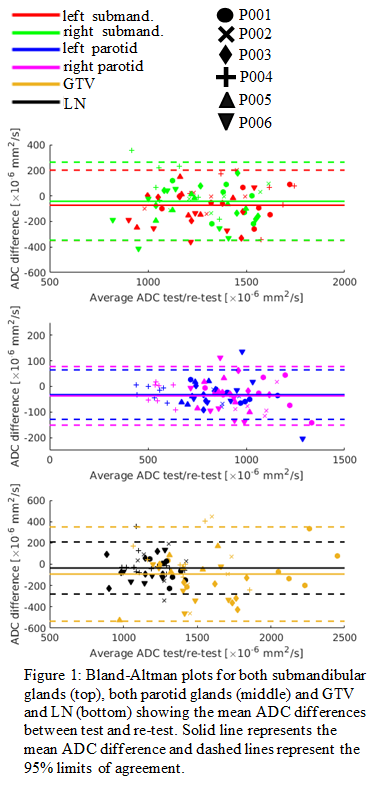Repeatability of diffusion-weighted MRI in head and neck cancer at a 1.5 T MR-Linac
PH-0215
Abstract
Repeatability of diffusion-weighted MRI in head and neck cancer at a 1.5 T MR-Linac
Authors: Jonas Habrich1, Simon Boeke2, Marcel Nachbar1, Konstantin Nikolaou3, Fritz Schick4, Cihan Gani2, Daniel Zips2, Daniela Thorwarth1
1University of Tübingen, Section for Biomedical Physics, Department of Radiation Oncology, Tübingen, Germany; 2University Hospital and Medical Faculty, University of Tübingen, Department of Radiation Oncology, Tübingen, Germany; 3University Hospital Tübingen, Department of Radiology, Tübingen, Germany; 4University of Tübingen, Section for Experimental Radiology, Department of Diagnostic Radiology, Tübingen, Germany
Show Affiliations
Hide Affiliations
Purpose or Objective
With the clinical introduction of hybrid MR-Linacs (MRL), sequential assessment of functional tumor characteristics during radiotherapy (RT) seems highly promising with respect to biologically adapted RT approaches. Studies using offline MRI suggest a prognostic value of apparent diffusion coefficients (ADC) assessed via diffusion weighted (DW) MRI in head and neck cancer (HNC) RT. Before clinical validation of ADC as imaging biomarker in online MR-adaptive RT, a dedicated technical validation is required.
The aim of this study was to determine the repeatability of ADC values derived from DW-MRI in patients with HNC acquired at a hybrid 1.5 T MRL.
Material and Methods
Six patients with locally advanced HNC were treated at the 1.5 T MRL and investigated with an extended imaging protocol (ethics approval No. 659/2017BO1). Sequential test/re-test measurements using an echo-planar-imaging (EPI) DW-MRI technique with b-values of 0, 150, 500 s/mm2 were performed once a week before (test) and after (re-test) the treatment session. ADC maps were calculated using a pixel-wise mono-exponential fit to signal amplitudes of the b150- and b500-images. Volumes of interest (VOI) including the gross tumor volume (GTV), all suspicious lymph nodes (LN), both submandibular and parotid glands were delineated manually on the b500-image. Voxel-based analysis was carried out for a voxelsize of 4.2x4.2x4 mm3. Repeatability coefficient (RC) as well as within-subject coefficient of variation (wCV) with respect to ADC were calculated on VOI- and voxel-level. Bland-Altman analysis was used for VOI-based results.
Results
A total of 40 test/retest measurements were available for analysis. Mean ADC values for GTV, LN, left/right submandibular and parotid gland were 1370, 1152, 1270/1228 and 792/837 ∙10-6 mm2/s, respectively. On the VOI-level wCV ranged between 3.3% in the parotid glands and 8.3% in the GTV. Accordingly, RCs in the range 81-335∙10-6 mm2/s were observed. On a voxel-level, a mean wCV of 28.4% over all VOIs was determined. RC and wCV for VOI- and voxel-based evaluation are presented in Table 1. Figure 1 shows Bland-Altman plots for all six VOIs. Mean ADC differences for GTV, LN, left/right submandibular and parotid glands were -92.2, -35.5, -73.5/-42.1, -32.0/-36.8 ∙10-6 mm2/s, respectively.
|
| Submand. left | Submand. right | Parotid left | Parotid right | GTV | LN |
VOI | RC [∙10-6 mm2/s] | 217.5 | 221.2 | 81.0 | 95.1 | 334.5 | 177.8 |
| wCV [%] | 6.2 | 7.1 | 3.3 | 3.8 | 8.3 | 5.5 |
Voxel-level | RC [∙10-6 mm2/s] | 695.7 | 734.7 | 541.1 | 548.3 | 939.1 | 797.3 |
| wCV [%] | 23.6 | 26.4 | 32.4 | 29.7 | 29.1 | 29.4 |

Conclusion
Repeatability analysis of EPI-based DW-MRI acquired on a hybrid MRL in HNC showed promising results and supports further development towards quantitative MRI for online adaptive RT. Further validation of these results including more patients and multi-center comparison is ongoing. Small systematic changes could possibly be attributed to treatment effects.
Funding: DFG (ZI 736/2-1, PAK 997/1).